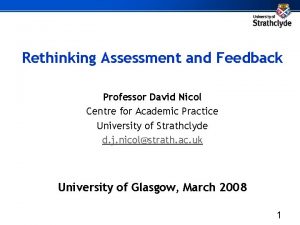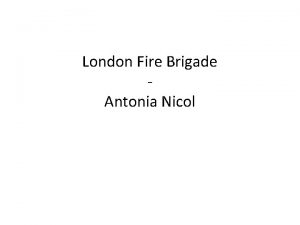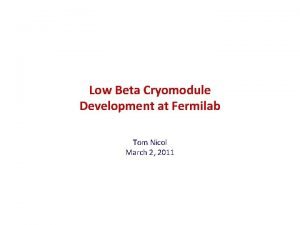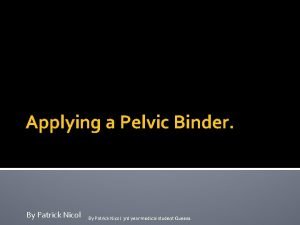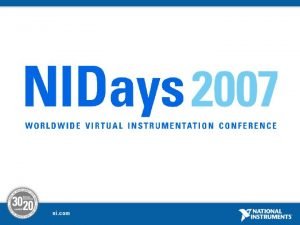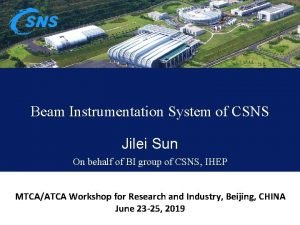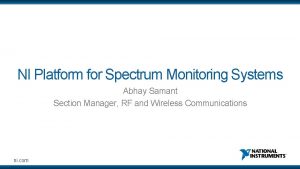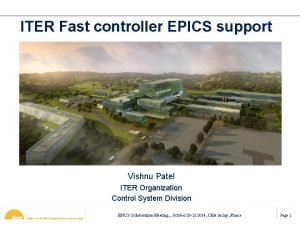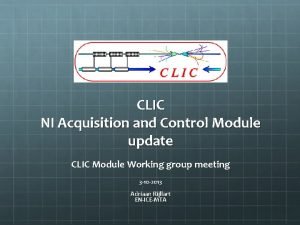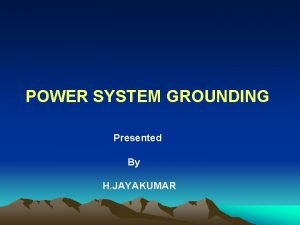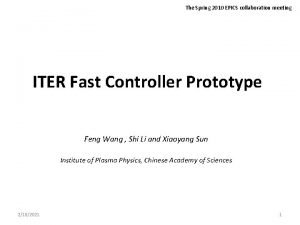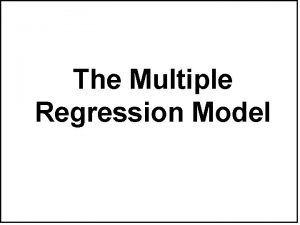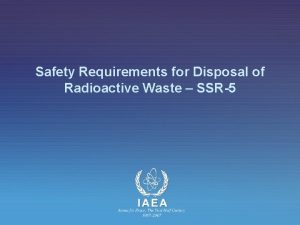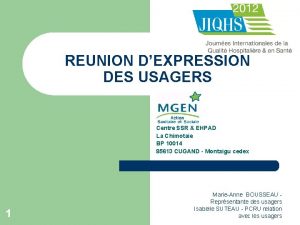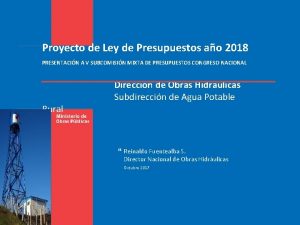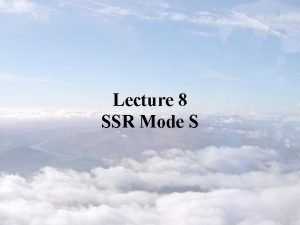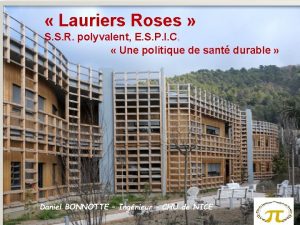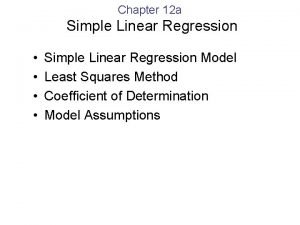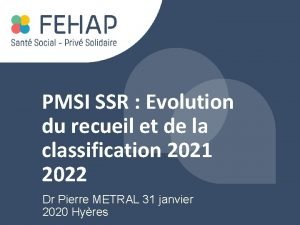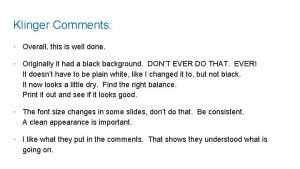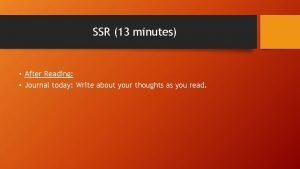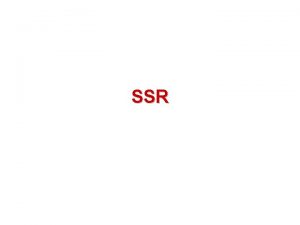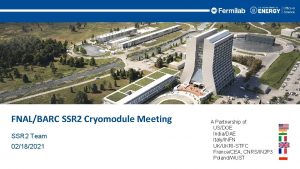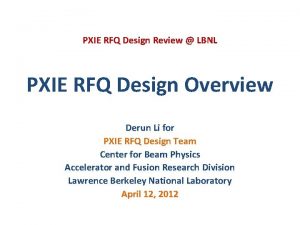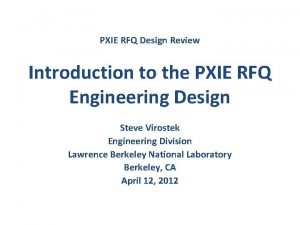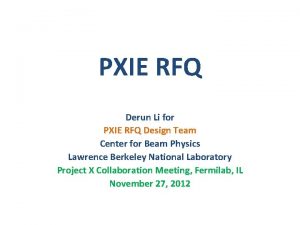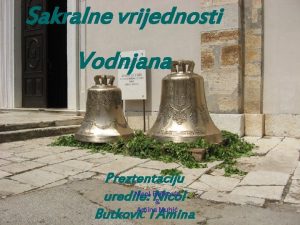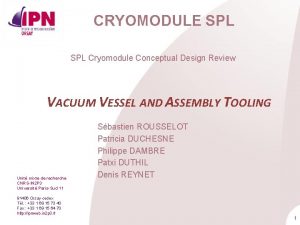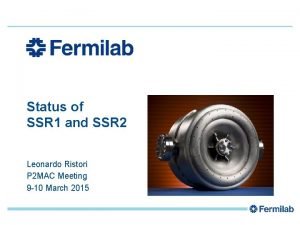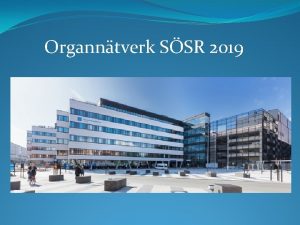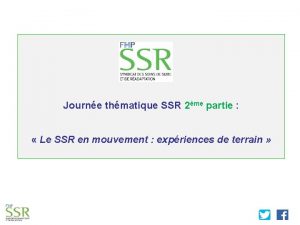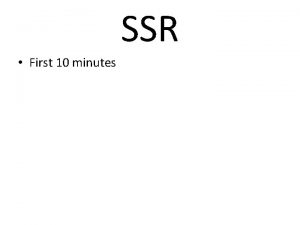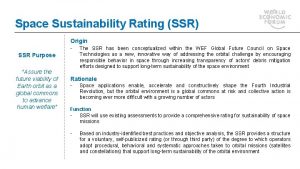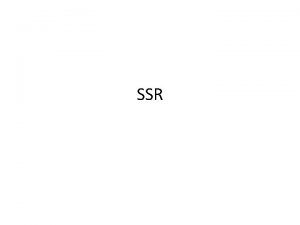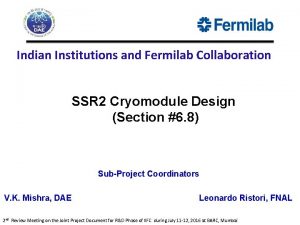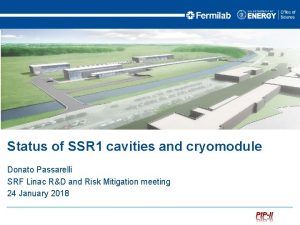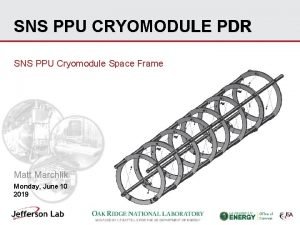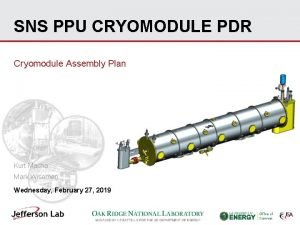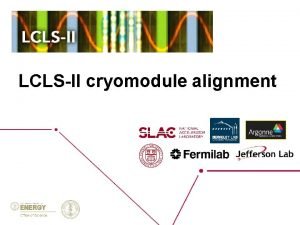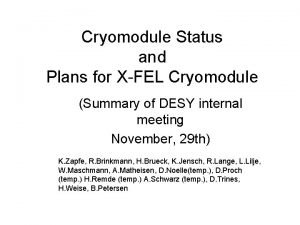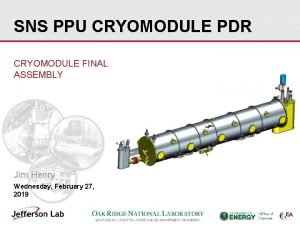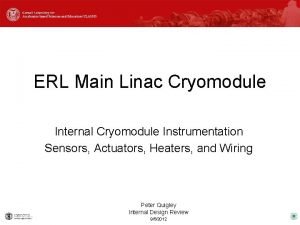SSR 1 Cryomodule Tom Nicol PXIE Program Review




























- Slides: 28

SSR 1 Cryomodule Tom Nicol PXIE Program Review January 16 -17, 2013

SSR 1 Cryomodule Design and Development Goals • • • Validate new spoke cavity cryomodule design concepts. – – – Room temperature strongback. Individual support posts to control axial motion. Conduction cooled magnet current leads (not new, but new to us). Single-window coaxial input coupler. Integral beam instrumentation. … Gain experience with the required alignment tolerances. Estimate static and dynamic heat loads. Check alignment stability during cooldown. Minimize risk ahead of full Project X design and production effort by gaining experience with strings of spoke cavities, solenoids, and beam instrumentation, e. g. cleanroom operations, final assembly in the vacuum vessel, shipping and handling, etc. Determine the practicality of tuner access ports. PXIE Review, Tom Nicol 2

SSR 1 Cryomodule Functional Requirements Specification http: //projectx-docdb. fnal. gov: 8080/cgi-bin/Show. Document? docid=931 PXIE Review, Tom Nicol 3

SSR 1 Cryomodule Functional Requirements Specification PXIE Review, Tom Nicol 4

SSR 1 Cryomodule Functional Requirements Specification • INTERFACES – Bayonet connections for helium supply and return. – Cryogenic valve control systems. – Cryogenic system interface is via a heat exchanger which pre-cools helium from approximately 5 K to 2 K upstream of the cryomodule liquid level control valve (JTvalve). – Pumping and pressure relief line connections. – Cryomodule warm support structures. – Beam tube connections terminated by a particle free vacuum valve. – RF cables to the input couplers. – Instrumentation connectors on the vacuum vessel shell. – Power supply cables for the solenoid and corrector connections. – Alignment fiducials on the vacuum vessel shell with reference to cavity positions. PXIE Review, Tom Nicol • INSTRUMENTATION – Beam position monitors. – Cavity field probes. – Coupler e-probes. – Diode x-ray detectors. – Cavity tuner control and diagnostics. – Input coupler temperature sensors. – Thermal shield temperature sensors. – Cavity helium vessel temperature sensors (externally mounted). – Cavity helium vessel heater (externally mounted). – Helium system pressure taps. – Helium level probes in the 2 K phase separator. – Helium temperature sensors in the 2 K phase separator. – Cavity vacuum monitors. – Insulating vacuum monitors. – Input coupler vacuum monitors. 5

SSR 1 Cryomodule Engineering Risk Assessment Driven mainly by “not off-theshelf” technology and resource availability Project: PXIE SSR 1 Cryomodule Lead Engineer: Tom Nicol Department: TD/SRF Date: February 27, 2012 1 3 4 5 6 7 8 9 Chapter Requirements and Specifications Requirements and Specification Review System Design Engineering Design Review Procurement and Implementation Testing and Validation Release to Operations Final Documentation H 3 A B C D E F G Engineering Risk Elements Technology Environmental Impact Vendor Issues Resource Availability Safety Quality Requirements Manufacturing Complexity PXIE Review, Tom Nicol A 4 4 4 Engineering Risk Element B C D E F 2 3 2 4 3 3 2 3 3 3 2 4 3 3 3 2 3 G 3 3 High Risk ≥ 10 ≥ 16 ≥ 19 ≥ 16 ≥ 13 ≥ 4 ≥ 7 Subtotal 9 16 18 18 15 13 3 5 I 4 Project Risk Element J K L M 2 1 1 3 O 3 High Risk ≥ 25 Subtotal Assessment 18 Standard Risk N 1 H I J K L M N O Assessment Standard Risk High Risk Standard Risk Project Risk Elements Schedule Interfaces Experience / Capability Regulatory Requirements Project Funding Project Reporting Requirements Public Impact Project Cost Driven mainly by testing requirements 6

SSR 1 Cryomodule Conceptual Design PXIE Review, Tom Nicol 7

SSR 1 Cryomodule Room Temperature Strongback and Support Posts PXIE Review, Tom Nicol 8

Strongback Temperature Distribution Analysis from VECC üStrong back material is taken as Stainless steel. ü Maximum temperature : 298 K. ü Minimum temperature : 296 K. Thanks to Anjan Duttagupta - Variable Energy Cyclotron Centre (VECC), Kolkata, India 9

SSR 1 Cavity and Helium Vessel PXIE Review, Tom Nicol 10

SSR 1 Cavity Tuner Assembly Stepper Motor PXIE Review, Tom Nicol 2 nd Arm Piezos Probe Main Arm Fulcrum 11

Status of New 325 MHz SSR 1 Cavities • • • PXIE Review, Tom Nicol Received all 10 production SSR 1 cavities – Performed incoming inspections on 6 cavities (visual, CMM, leak check, RF) 4 cavities tested in VTS – 3 exceeded PXIE requirements at first test – S 106 developed a leak at the beam pipe and will receive a ndw end wall – S 108 reached ~10 MV/m and will be retested after additional HPR 8 dressed cavities will become part of the PXIE SSR 1 cryomodule 12

SSR 1 VTS Test Summary as of Dec 2012 FE limited, will be re-rinsed and retested after S 110 5 more bare cavities (S 110 -S 114) will be tested in VTS between now and June 2013 Jacketing operations of first cavity (S 107) will occur in Spring 2013. PXIE Review, Tom Nicol 13

SSR 1 Cavity Tuner Access Ports Tuner access ports PXIE Review, Tom Nicol 14

SSR 1 Dressed Cavity Pressure Vessel Code Analysis Protection against plastic collapse Protection against local failure Protection against collapse from buckling Protection against cyclic loading Ratcheting ü There is no plastic deformation in the overall dimension of the SSR 1 resonator PXIE Review, Tom Nicol Fatigue Assessment ü No fatigue analysis is necessary 15

SSR 1 Dressed Cavity Pressure Vessel Code Analysis from VECC Thanks to Anjan Duttagupta - Variable Energy Cyclotron Centre (VECC), Kolkata, India 16

SSR 1 Cryomodule Input Coupler • • • Beam power gain per cavity (CW). – PXIE (SSR 1): ~2 k. W. – Project X, 1 m. A (SSR 2): ~3. 5 k. W. – Project X, 5 ma (SSR 2): ~18 k. W. Maximum design power. – Project X, 5 m. A: ~30 k. W. One ceramic window at room temperature. No external adjustment. Air cooled center conductor. PXIE Review, Tom Nicol 17

SSR 1 Cryomodule Focusing Solenoid PXIE Review, Tom Nicol 18

SSR 1 Cryomodule Focusing Solenoid PXIE Review, Tom Nicol 19

SSR 1 Cryomodule Current Leads Concept 2: Conduction cooled leads similar to CERN and DESY leads. Concept 1: Fin heat exchangers at 70 K and 4. 5 K connected by copper conductor. PXIE Review, Tom Nicol 20

SSR 1 Cavity String Details Beam position monitor Solenoid and helium vessel Beam valve 2 -phase pipe Thermal shield Strongback PXIE Review, Tom Nicol Cold coupler half 21

SSR 1 Cavity String Spacing 800 mm 450 mm 1250 mm PXIE Review, Tom Nicol 22

SSR 1 Cryomodule Alignment of Internal Components The idea is to replicate the assembly table support locations inside the vacuum vessel to maintain alignment during insertion. PXIE Review, Tom Nicol 23

SSR 1 Cryomodule Cross Section PXIE Review, Tom Nicol 24

SSR 1 Cryomodule Heat Load Estimates T. Nicol -February 9, 2012 SSR 1 8 cavities, 4 solenoids 80 K Input coupler static 5. 36 Input coupler dynamic 0. 00 Cavity dynamic load 0. 00 Support post 2. 76 Conduction lead assembly 36. 80 MLI (total 70 K + 2 K) 30. 54 Cold to warm transition 0. 72 Total Each unit 4. 5 K 2. 82 0. 00 0. 36 13. 20 0. 08 Mult 2 K 0. 50 0. 25 1. 78 0. 05 1. 24 1. 42 0. 01 8 8 8 12 4 1 2 70 K 42. 88 0. 00 33. 12 147. 20 30. 54 1. 44 255. 2 Total 4. 5 K 22. 56 0. 00 4. 32 52. 80 0. 00 0. 16 79. 8 2 K 4. 00 2. 00 14. 24 0. 60 4. 96 1. 42 0. 02 27. 2 Notes: 1. Cavity dynamic loads from Nikolai Solyak, February 2012. 2. Input coupler static loads from S. Kazakov, February 2012, no copper plating on outer conductor, intercepts at 15 K and 125 K. 3. Current lead heat loads assume 2 coils at 50 A, 1 coil at 200 A. PXIE Review, Tom Nicol 25

Summary • • Good progress is being made on each of the main sub-components. – – Support system. Cavities, helium vessels and tuners. Solenoids and current leads. Input couplers. Integration of them all into the overall cryomodule design is going well. Our preliminary solid model has been turned over to design/drafting. We’ve answered many of the big questions posed when first starting. – – – Solenoid strength, operating temperature, type of cooling, etc. One or two coupler windows. Tuner access ports. Alignment verification technique. Etc. We need to build some of the new hardware to continue to learn where potential challenges exist. PXIE Review, Tom Nicol 26

Status of Activities • • First production batch of 10 cavities is complete. Helium vessel design and review are complete. Bids closed on first procurement batch week ending of January 11. Detailed design of the tuner is in-process. Design of the solenoid and current leads are in-process. Input coupler and test stand have been reviewed, procurement of prototypes is in-process, test plans are in-process. Alignment is a known challenge, but a plan exists to address the requirements and to verify individual component positions after assembly and cooldown. Cryomodule design review is scheduled in early February. PXIE Review, Tom Nicol 27

Schedule Milestones ~Oct 2013 ~Aug 2014 ~Nov 2014 ~Apr 2016 Now PXIE Review, Tom Nicol 28
 Robbie nicol
Robbie nicol Professor david nicol
Professor david nicol Antonia nicol
Antonia nicol Claude nicol centre
Claude nicol centre Nicol beta
Nicol beta Fah nicol
Fah nicol Patrick nicol
Patrick nicol Multicore vs multiprocessor
Multicore vs multiprocessor Pxie-5160
Pxie-5160 Pxie-5667
Pxie-5667 Pxie-6368
Pxie-6368 Ni-6584
Ni-6584 Pxie-6396
Pxie-6396 Pxie-6368
Pxie-6368 Pcie-8375
Pcie-8375 Tom tom go 910
Tom tom go 910 Symbols in the devil and tom walker
Symbols in the devil and tom walker Yt
Yt Ssr-5
Ssr-5 Ssr-5
Ssr-5 Compilazione ricetta rossa
Compilazione ricetta rossa Centre ssr la chimotaie
Centre ssr la chimotaie Ssr licancheu.cl
Ssr licancheu.cl Ssr mode s
Ssr mode s Ssr les lauriers
Ssr les lauriers R2 = ssr/sst
R2 = ssr/sst Nouveautés pmsi 2021
Nouveautés pmsi 2021 Ssr chipotle
Ssr chipotle Ssr 13
Ssr 13

